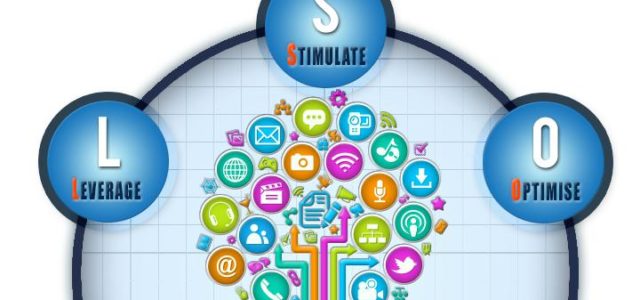In my last article on this topic, I outlined ten digital marketing strategies that accelerate the growth of managed services revenue. Managed services, unlike project-based services, break the feast-or-famine cycle, are usually scalable and stabilize profits. This can lead to EBITDA that is well above industry averages.
My thesis is that digital marketing should front-end the sales cycle of managed services. Great digital marketing builds trust, increases your win-rates and creates buy-in to your approach. Creating buy-in is essential to retaining clients for the long-term, which impact profits.
There are two parts to a digital marketing plan: infrastructure and outbound. In this article I want to give you insights into five outbound digital marketing strategies. These strategies are based on the real-world experience of numerous professional service firms today who have grown managed services substantially. These practices account for millions of dollars in net-new, high-profit and annually-repeatable revenue. Let me show you what actually works today.
TWO PARTS TO THE STRATEGY
In case you did not see my prior article on this topic, here is a quick review. There are two key parts to an effective managed service digital marketing plan: infrastructure marketing and outbound marketing.
Managed services infrastructure marketing includes:
- Ideal client profile
- The promise
- Clear managed service descriptions
- Client testimonials
- Thought leadership content
Managed services outbound marketing includes:
- The ultimate digital marketing stack
- Content marketing
- Website marketing
- Email marketing
- Social media marketing
Infrastructure marketing is what you do to prepare to go to market and to pull prospects through the sales funnel once they begin to lean-in. Outbound marketing is what you do to get them to lean-in and consider your firm. Both infrastructure and outbound marketing are designed to accelerate autonomous movement through the sales funnel which includes these stages:
Awareness: a prospect becomes aware of your brand, services and people.
Consideration: a prospect considers how you can help them.
Interest: a prospect enters dialogue and requests a proposal.
Evaluation: a prospect evaluates your proposal against their needs and competitive offerings.
Selection: a prospect accepts your proposal and moves to next steps.
—————————————————–KEY TAKE-AWAY:JUST BECAUSE YOU DO EVERYTHING RIGHT IN THE MARKETING FUNCTION, THIS DOES NOT GUARANTEE THAT YOU’LL GROW AND ACQUIRE GREAT NEW CLIENTS.—————————————————–
UNITING SALES, MARKETING & DELIVERY
Before I review the five outbound digital marketing strategies, I want to make this key point. Just because you do everything right with the marketing plan, this does not guarantee that you’ll grow and acquire great new clients. To acquire new clients, marketing, sales and delivery have to unite around a common vision and approach.
Here is the way I think of this. To achieve meaningful managed services success, marketing makes a promise that ideal prospects cannot resist. The sales or business development function applies the promise to each unique business opportunity. The delivery function delivers the promise to the client based on the proposal. This is how you grow managed services at an exceptional rate.
The infrastructure strategies I described in my previous article must be developed in concert with the sales and delivery function leaders. Marketing leaders can drive this process but cannot achieve meaningful success without the support and buy-in of the other two functions.
So as you review the strategies I’m about to describe, think about how you can unite these three functions around this process. I use the term “functions” rather than “teams” because many of our clients don’t have distinct lines between these functions. For example, many of our clients have senior leaders who are responsible for both business development and service delivery.
THE ULTIMATE DIGITAL MARKETING STACK
Before you can engage in digital marketing, you need the right digital tools, or what software architects call a stack. My team has evaluated a wide range of digital strategies and tools over the last several years. Our role is to be the think-tank, trying different things to see what works and what doesn’t work. This allows us to be an effective guide to our clients so they only focus on what works.
After executing literally thousands of digital marketing campaigns and tracking the results using quantitative metrics, I can say without hesitation that you need four key tools. I call these tools the ultimate digital marketing stack. The stack can be summarized with this formula: CMS+MA+CRM+SMM = Success.
CMS stands for content management system. This is the tool that is used to build a website. The most popular CMS today is Word Press. But there are also hundreds of other CMS’s available and they all have their pros and cons. If you have an internal team who plans to add content to your website without the help of coders, it’s important to have an easy-to-use CMS interface.
MA stands for marketing automation. There are dozens of MA systems available today and they all have their strengths and weaknesses. We recommend MA platforms that track the entire digital footprint of users. Marketing automation platforms of nearly any flavor also include an email marketing engine.
CRM stands for client relationship manager. The most popular CRM today is Salesforce and we use it all the time. Most of our clients have a tight integration between the marketing automation platform and the CRM with regular synchs of the data. A CRM is crucial to organizations with sales or business development teams.
SMM stands for social media manager. This is a relatively new type of tool that many service firms are just beginning to discover. A social media manager allows service firms to provision content onto different social platforms, like LinkedIn, Facebook and Twitter, with little to no effort from busy executives.
CONTENT MARKETING
In my last article, I described how to brainstorm great advice for ideal clients. It’s very important not to just start writing on any old topic or to shift this responsibility to a social media manager who may not know your business. Your content has to address the top goals, opportunities and challenges of prospective ideal clients.
Once you have your advice documented, it’s time to create content marketing pieces. What type of content marketing should you create? We recommend at least these four types:
- Insightful blog-posts or articles.
- Fully fleshed-out Ebooks.
- Video-based action guides.
- Online conferences or webinars.
Insightful blog-posts and articles are critical for three reasons. First, it is expected today because everyone knows about blogs. Second, it allows users to skim topics to find ideas that interest them. Third, the articles can and should be shared over to social media sites.
Remember, the goal of this activity is to create buy-in to your approach and a set of short articles on topics that matter to ideal clients can be irresistible to them. Many blog-style articles today are between 1,000 and 2,000 words.
Now let’s turn to Ebooks. I keep two folders on my desktop: one called good ebooks and the other called bad ebooks. A good ebook is rich with insights and usually addresses a cluster of goals, opportunities and challenges of ideal clients. While a blog-post may be 1,000 words, many good ebooks are 10,000 words or more. The most important goal an ebook can accomplish is to create forward movement in the sales funnel. If an ideal prospect downloads an ebook and is not impressed with it, it didn’t help you.
We use video-based action guides. We get a lot of registrations for these and people tell me all the time how much they like them. Most of the clients who buy our managed services have registered for an action guide at some point on their journey. These tools, however, are challenging to build and require a level of sophistication that most mid-size service firms simply do not have.
Some of our clients develop online conferences while others only use webinars. For our brand, we develop both traditional short webinars of under 30 minutes and longer-form webinars that are multi-part in their focus. We developed a multi-part webinar with James Hickey, CEO of The Alliott Group, for the CPA industry.
WEBSITE MARKETING
All roads should lead back to your website. That is the guiding principle behind the strategies I recommend. Whatever you might do with email, social media and content marketing, the goal is to drive organic prospects toward your website. Here is why. If you do this the right way, prospects will go from considering your ideas to considering your managed services.
We see prospects engage in this sort of behavior all the time. For example, they’ll click over to our website, read a blog-post or two, download an ebook and then click on a specific service that interests them. The strategy is simple: idea first, service second. Ideas should come first because they build trust. When ideas are first, this says something important to the prospect: I care about you and what you care about.
This is almost the exact opposite way that most service organizations develop their websites. They usually build a website that is all about them. I think that’s wrong. A great professional service website is all about ideal clients, giving them insights they need to achieve their goals.
I believe the whole point of this exercise is to convince ideal prospects that your approach is the right one and then to leave them with a question. Who do we trust to do this? Usually the options are to do it themselves, to hire someone else or to hire you – the expert. If you’ve given them ideas and show them proof statements like client testimonials and case studies, that prove you can do what you claim you can do, the likelihood is very high that they’ll at least engage you in dialogue.
—————————————————–KEY TAKE-AWAY:THE WHOLE POINT IS TO CONVINCE PROSPECTS THAT YOUR APPROACH IS BEST, LEAVING THEM WITH ONE SIMPLE QUESTION – WHO DO WE TRUST TO DO THIS?—————————————————–
EMAIL MARKETING
Despite what you may have heard, email marketing is still the king of the castle. No other strategy is as effective at driving real prospects toward managed services. My recommendation is that you use email marketing to promote your ideas, not so much your brand. An email newsletter that is consistent and insightful is crucial to success.
For email marketing to be effective, you need several things:
- A list of opt-in prospects who fit your ideal client profile.
- A newsletter brand name – probably not your company brand name.
- An email marketing tool – which should be part of a marketing automation system.
- Meaningful and insightful content that you produce consistently.
- An editorial calendar – such as what publishers use.
Email marketing is ultimately a form of lead nurturing. The goal of email marketing is not to generate leads but instead to nurture leads over time with great ideas. It’s relatively easy today to add “leads” to a CRM and marketing automation system. It’s much more challenging to get those leads to engage.
Email marketing is based on one simple principle: the 95-5 rule. This rule holds that 95% of the people you are marketing to at any given time are not ready to enter serious sales dialogue. However, if you build content that matters to your audience and consistently provision it to them, over time, nearly all of them will encounter need, budget, timeline, reason and willingness to engage in dialogue. This is why email marketing is critical to your ultimate success.
SOCIAL MEDIA MARKETING
If you think that social media is a waste of time and just a bunch of silly cat videos, think again. There are two social media platforms today that offer real business value for service firms: LinkedIn and Twitter. My recommendation is that you put 90% of your effort into LinkedIn and 10% into Twitter.
LinkedIn is not only the world’s biggest and best social media platform for business professionals, it’s also the single biggest prospecting ecosystem I’ve ever seen. I will virtually guarantee that the people to whom you want to sell managed services are on LinkedIn. I don’t have room in this article to describe everything you need to do on LinkedIn. But here is a short-list of solid advice:
- If you have a free account, consider upgrading to premium.
- Make sure all of the top people at your firm have at least 500 first-tier connections.
- Provision your thought leadership articles to your LinkedIn profile.
- Join at least 10 groups who aggregate your ideal client.
- Provision thought leadership content into your groups with short posts.
- Consider a tool like LinkedIn Sales Navigator to find ideal prospects and connect to them.
MEASURING GENESIS AND JOURNEY
With these ten marketing and business development strategies, you have a powerful machine at your fingertips. But I want to introduce two final concepts that I believe are crucial for you to measure and track: genesis and journey.
Genesis is about where a lead comes from. Genesis tells you how they got started on the journey. This is crucial because you want to be able to identify as many Genesis points as possible so you can rinse and repeat. In our experience, email marketing, social media marketing and content marketing can all be great Genesis points.
But there are others, such as SEO. More Genesis points are emerging all the time. I believe you need a multi-channel digital marketing strategy. But you also need a way to track which Genesis points are producing the best results.
You also need to be able to track the journey. Most people need to warm up to a service provider and to an approach to solving their problems. I call this building buy-in. But the problem with digital marketing is that people might be buying-in, but you don’t know about it. After all, people don’t call you to tell you they’re visiting your website.
This is where MA becomes really important. You need a marketing automation platform that accurately identifies individual users and tracks their behavior. This allows business development consultants to tailor their initial conversations to what matters to prospects, which expedites forward movement in the sales funnel.
Try these ten digital marketing strategies for managed services because I know they work.
Article by channel:
Everything you need to know about Digital Transformation
The best articles, news and events direct to your inbox
Read more articles tagged: Content Marketing, Digital Marketing, Featured







